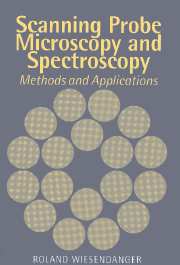Book contents
- Frontmatter
- Contents
- Preface
- List of acronyms
- Introduction
- Part one Experimental methods and theoretical background of scanning probe microscopy and spectroscopy
- Part two Applications of scanning probe microscopy and spectroscopy
- 4 Condensed matter physics
- 5 Chemistry
- 6 Organic material
- 7 Metrology and standards
- 8 Nanotechnology
- References
- Index
5 - Chemistry
Published online by Cambridge University Press: 05 October 2010
- Frontmatter
- Contents
- Preface
- List of acronyms
- Introduction
- Part one Experimental methods and theoretical background of scanning probe microscopy and spectroscopy
- Part two Applications of scanning probe microscopy and spectroscopy
- 4 Condensed matter physics
- 5 Chemistry
- 6 Organic material
- 7 Metrology and standards
- 8 Nanotechnology
- References
- Index
Summary
STM and related scanning probe microscopies (SPM) have become important experimental techniques in chemistry, particularly solid state chemistry, as well as in solid state physics. There exist two major fields where SPM has already made significant contributions.
Chemical reactions at the solid–vacuum interface, i.e. surface reactions, which are in the focus of surface science research where the border between surface chemistry and surface physics (section 4.1) has become blurred.
Chemical reactions at the solid–liquid interface, particularly those initiated by electrochemical processes.
In the following, we will concentrate on some of the achievements of STM and related SPM techniques towards an atomic-level understanding of chemical reaction processes occurring at the solid–vacuum interface (section 5.1) and the solid–liquid interface (section 5.2).
Surface reactions
STM, or generally SPM, can contribute in various ways to a detailed investigation of surface chemical reactions.
Characterization of the atomic and electronic structure of the as-prepared surface before the initiation of chemical reactions is important to identify the variety of inequivalent surface sites and their structural as well as electronic characteristics.
In the initial stage of the reaction process, site-specific modifications of the substrate surface and chemisorbed species have to be characterized. In particular, a correlation between the local reactivity and the atomic and electronic properties of individual surface sites has to be established. As the chemical reaction proceeds, it is also important to study how the reaction at one particular surface site affects the local electronic structure of neighboring sites with possible influences on their local reactivity. This way, detailed information about the mechanism of the surface chemical reaction, from the initial nucleation to the growth of reacted surface regions, can be obtained.
[…]
- Type
- Chapter
- Information
- Scanning Probe Microscopy and SpectroscopyMethods and Applications, pp. 468 - 492Publisher: Cambridge University PressPrint publication year: 1994

